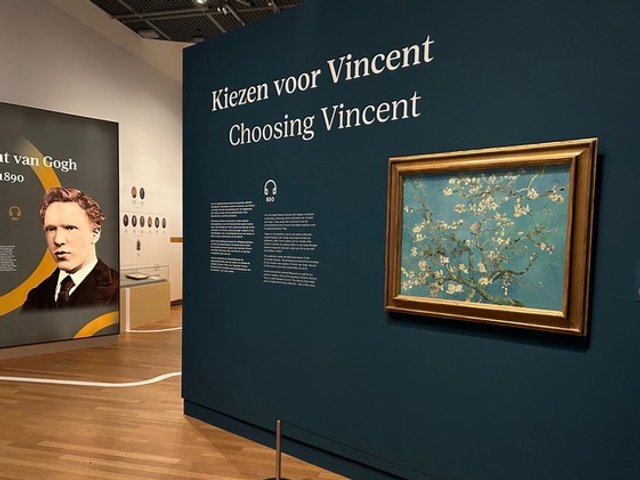Blossoming almond trees signal the arrival of spring in Provence, being the first of the fruit trees to burst into flower. Van Gogh captured an image of the short-lived blossom while he was living at the asylum of Saint-Paul-de-Mausole, in an area in southern France renowned for its almonds. Almond Blossom, a still life with branches set against a blue background, is one of his most optimistic paintings.

Almond trees just outside Saint-Paul-de-Mausole, with the asylum’s church in the background, postcard (1920s)
In winter almond trees appear stark. In Van Gogh’s Fields near Les Alpilles (November 1889), a solitary one with bare branches dominates the centre of this cold scene, its claw-like branches silhouetted against the hills and reaching for the sky. This painting, which belonged to couturier Yves Saint Laurent and his partner Pierre Bergé, sold at Christie’s in 2022 for $52m.

Van Gogh’s Fields near Les Alpilles (November 1889)
© Christie’s Images
But with the approach of spring, almond trees become transformed. Van Gogh saw the first blossoming trees from his bedroom window, growing in the lower foothills of Les Alpilles (the little Alps). View of Les Alpilles, painted in February 1890, could hardly represent a greater contrast with his November landscape, completed just three months earlier.

Van Gogh’s View of Les Alpilles (February 1890)
© Van Gogh Museum, Amsterdam (Vincent van Gogh Foundation)
It must have been a memorable moment when Van Gogh was allowed outside the asylum’s high walls and got close to a tree which was a mass of delicate white petals with heady honey-like scent. He probably conceived the still life Almond Blossom, with the branches set against blue, on 19 February 1890, a couple of days after a marked rise in the temperature led the buds to burst out.
At first glance his composition of blossoming branches appears quite natural, as if he had lain on the ground and gazed up at the clear sky through the gnarled branches. But a closer examination suggests that it is an artfully complex composition. The branches in the upper-right corner and the crossing ones in the lower part of the painting seem to come from three separate trees.
Van Gogh probably broke off a few branches from the almond tree and carried them back to his studio. He then allowed his imagination to come into play, inspiring him to create a delicate scattering of fresh petals strewn across an azure sky.
His composition was clearly inspired by Japanese prints, which often feature dramatically cropped trees. Spring blossom is also a much-loved motif in Japan.

Three Japanese prints of blossom, all from the collection of Vincent and Theo van Gogh, left to right: Utagawa Kunisada’s A Flower Game in the Garden (1830s); Utagawa Hiroshige’s The Outskirts of Koshigaya in Musashi Province (1858); and Hiroshige’s Ishiyakushi: The Yoshitsune Cherry Tree near the Noriyori Shrine (1855)
Credits: Van Gogh Museum, Amsterdam (Vincent van Gogh Foundation)
Tragically, immediately after completing Almond Blossom, Vincent was struck down by yet another mental crisis, which occurred during a short trip to nearby Arles, to see friends. “Work was going well, the last canvas of the branches in blossom... and the next day done for like a brute”, he later wrote to his brother Theo. Vincent was seriously ill for just over a week.
Almond Blossom had been painted for the son of Theo and his wife Jo. Born on 31 January 1890, the child had been named Vincent Willem, after the artist, who was also his godfather. As Vincent explained to his mother Anna, the picture was for the bedroom of Theo and Jo’s Paris apartment, where the baby slept: “large branches of white almond blossom against a blue sky”.
When Almond Blossom arrived in Paris with a consignment of paintings, Theo was delighted and singled it out for particular praise. Although Vincent had suggested it should hang in the bedroom, the couple displayed it more prominently in their sitting room, above the piano.
This joyful picture remained among the favourites of Vincent Willem throughout his life. Vincent Willem’s son, Johan van Gogh, told me that he vividly remembered it from the 1930s, when it hung in the bedroom which he shared with his two brothers in the family home in Laren, a village outside Amsterdam.
Recalling his childhood, Johan said that it was “a miracle that it was never hit by a flying pillow, or worse”. The painting later became part of the collection of Amsterdam’s Van Gogh Museum, where it is now treated with rather greater care. Johan, who died in 2019 at the age of 96, said that whenever he saw the painting he would recall that this picture had been created to mark the birth of his father.

Almond tree near Saint-Rémy-de-Provence
© Martin Bailey
On a visit to Saint-Rémy I managed to track down what may well have been the actual almond tree whose blossoms Van Gogh captured in paint. Two long-time residents who were well informed about the history of the asylum showed me the venerable tree, on the outskirts of the town of Saint-Rémy-de-Provence.
Almond trees can live for 150 years and the evidence they gave me that this was the one depicted by Van Gogh was persuasive, although not absolutely conclusive. I am reluctant to reveal further details, since identifying the location could well endanger its life. A few visitors might follow the artist’s example and break off blossom-covered twigs in early spring. It could quickly become a place of pilgrimage, for those seeking relics.
Other Van Gogh news:
Van Gogh’s Head of a Woman (Gordina de Groot) (March-April 1885) sold at Christie’s for £4,842,000 on 28 February. The successful bidder was in the London auction room. The estimate had been £1m-£2m.








